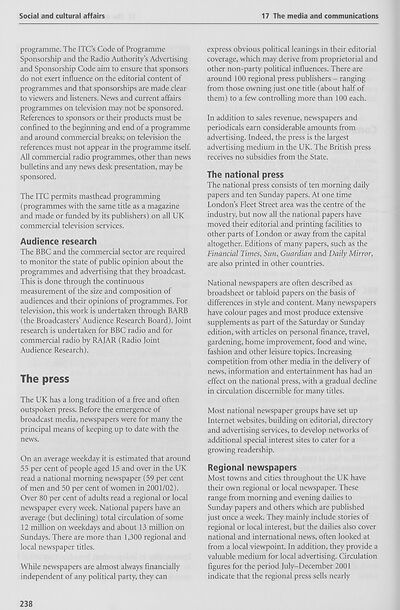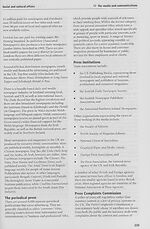Download files
Complete book:
Individual page:
Thumbnail gallery: Grid view | List view

Social and cultural affairs
17 The media and communications
programme. The ITC’s Code of Programme
Sponsorship and the Radio Authority’s Advertising
and Sponsorship Code aim to ensure that sponsors
do not exert influence on the editorial content of
programmes and that sponsorships are made clear
to viewers and listeners. News and current affairs
programmes on television may not be sponsored.
References to sponsors or their products must be
confined to the beginning and end of a programme
and around commercial breaks; on television the
references must not appear in the programme itself.
All commercial radio programmes, other than news
bulletins and any news desk presentation, may be
sponsored.
The ITC permits masthead programming
(programmes with the same title as a magazine
and made or funded by its publishers) on all UK
commercial television services.
Audience research
The BBC and the commercial sector are required
to monitor the state of public opinion about the
programmes and advertising that they broadcast.
This is done through the continuous
measurement of the size and composition of
audiences and their opinions of programmes. For
television, this work is undertaken through BARB
(the Broadcasters’ Audience Research Board). Joint
research is undertaken for BBC radio and for
commercial radio by RAJAR (Radio Joint
Audience Research).
The press
The UK has a long tradition of a free and often
outspoken press. Before the emergence of
broadcast media, newspapers were for many the
principal means of keeping up to date with the
news.
On an average weekday it is estimated that around
55 per cent of people aged 15 and over in the UK
read a national morning newspaper (59 per cent
of men and 50 per cent of women in 2001/02).
Over 80 per cent of adults read a regional or local
newspaper every week. National papers have an
average (but declining) total circulation of some
12 million on weekdays and about 13 million on
Sundays. There are more than 1,300 regional and
local newspaper titles.
While newspapers are almost always financially
independent of any political party, they can
express obvious political leanings in their editorial
coverage, which may derive from proprietorial and
other non-party political influences. There are
around 100 regional press publishers - ranging
from those owning just one title (about half of
them) to a few controlling more than 100 each.
In addition to sales revenue, newspapers and
periodicals earn considerable amounts from
advertising. Indeed, the press is the largest
advertising medium in the UK. The British press
receives no subsidies from the State.
The national press
The national press consists of ten morning daily
papers and ten Sunday papers. At one time
London’s Fleet Street area was the centre of the
industry, but now all the national papers have
moved their editorial and printing facilities to
other parts of London or away from the capital
altogether. Editions of many papers, such as the
Financial Times, Sun, Guardian and Daily Mirror,
are also printed in other countries.
National newspapers are often described as
broadsheet or tabloid papers on the basis of
differences in style and content. Many newspapers
have colour pages and most produce extensive
supplements as part of the Saturday or Sunday
edition, with articles on personal finance, travel,
gardening, home improvement, food and wine,
fashion and other leisure topics. Increasing
competition from other media in the delivery of
news, information and entertainment has had an
effect on the national press, with a gradual decline
in circulation discernible for many titles.
Most national newspaper groups have set up
Internet websites, building on editorial, directory
and advertising services, to develop networks of
additional special interest sites to cater for a
growing readership.
Regional newspapers
Most towns and cities throughout the UK have
their own regional or local newspaper. These
range from morning and evening dailies to
Sunday papers and others which are published
just once a week. They mainly include stories of
regional or local interest, but the dailies also cover
national and international news, often looked at
from a local viewpoint. In addition, they provide a
valuable medium for local advertising. Circulation
figures for the period July-December 2001
indicate that the regional press sells nearly
238
17 The media and communications
programme. The ITC’s Code of Programme
Sponsorship and the Radio Authority’s Advertising
and Sponsorship Code aim to ensure that sponsors
do not exert influence on the editorial content of
programmes and that sponsorships are made clear
to viewers and listeners. News and current affairs
programmes on television may not be sponsored.
References to sponsors or their products must be
confined to the beginning and end of a programme
and around commercial breaks; on television the
references must not appear in the programme itself.
All commercial radio programmes, other than news
bulletins and any news desk presentation, may be
sponsored.
The ITC permits masthead programming
(programmes with the same title as a magazine
and made or funded by its publishers) on all UK
commercial television services.
Audience research
The BBC and the commercial sector are required
to monitor the state of public opinion about the
programmes and advertising that they broadcast.
This is done through the continuous
measurement of the size and composition of
audiences and their opinions of programmes. For
television, this work is undertaken through BARB
(the Broadcasters’ Audience Research Board). Joint
research is undertaken for BBC radio and for
commercial radio by RAJAR (Radio Joint
Audience Research).
The press
The UK has a long tradition of a free and often
outspoken press. Before the emergence of
broadcast media, newspapers were for many the
principal means of keeping up to date with the
news.
On an average weekday it is estimated that around
55 per cent of people aged 15 and over in the UK
read a national morning newspaper (59 per cent
of men and 50 per cent of women in 2001/02).
Over 80 per cent of adults read a regional or local
newspaper every week. National papers have an
average (but declining) total circulation of some
12 million on weekdays and about 13 million on
Sundays. There are more than 1,300 regional and
local newspaper titles.
While newspapers are almost always financially
independent of any political party, they can
express obvious political leanings in their editorial
coverage, which may derive from proprietorial and
other non-party political influences. There are
around 100 regional press publishers - ranging
from those owning just one title (about half of
them) to a few controlling more than 100 each.
In addition to sales revenue, newspapers and
periodicals earn considerable amounts from
advertising. Indeed, the press is the largest
advertising medium in the UK. The British press
receives no subsidies from the State.
The national press
The national press consists of ten morning daily
papers and ten Sunday papers. At one time
London’s Fleet Street area was the centre of the
industry, but now all the national papers have
moved their editorial and printing facilities to
other parts of London or away from the capital
altogether. Editions of many papers, such as the
Financial Times, Sun, Guardian and Daily Mirror,
are also printed in other countries.
National newspapers are often described as
broadsheet or tabloid papers on the basis of
differences in style and content. Many newspapers
have colour pages and most produce extensive
supplements as part of the Saturday or Sunday
edition, with articles on personal finance, travel,
gardening, home improvement, food and wine,
fashion and other leisure topics. Increasing
competition from other media in the delivery of
news, information and entertainment has had an
effect on the national press, with a gradual decline
in circulation discernible for many titles.
Most national newspaper groups have set up
Internet websites, building on editorial, directory
and advertising services, to develop networks of
additional special interest sites to cater for a
growing readership.
Regional newspapers
Most towns and cities throughout the UK have
their own regional or local newspaper. These
range from morning and evening dailies to
Sunday papers and others which are published
just once a week. They mainly include stories of
regional or local interest, but the dailies also cover
national and international news, often looked at
from a local viewpoint. In addition, they provide a
valuable medium for local advertising. Circulation
figures for the period July-December 2001
indicate that the regional press sells nearly
238
Set display mode to:
![]() Universal Viewer |
Universal Viewer | ![]() Mirador |
Large image | Transcription
Mirador |
Large image | Transcription
The item on this page appears courtesy of Office for National Statistics and may be re-used under the Open Government Licence for Public Sector Information.
| Britain and UK handbooks > UK: The official yearbook of the United Kingdom of Great Britain and Northern Ireland > 2003 > (268) |
|---|
| Permanent URL | https://digital.nls.uk/204926594 |
|---|
| Attribution and copyright: |
|
|---|---|
| Description | Three volumes of 'UK: The official yearbook of the United Kingdom of Great Britain and Northern Ireland', published annually by the Office of National Statistics from 2002-2005. |
|---|---|
| Shelfmark | GII.11 SER |
| Description | Three titles produced by the British Government from 1954-2005 describing 'how Britain worked'. They are: 'Britain: An official handbook' (1954-1998), 'Britain: The official yearbook of the United Kingdom' (1999-2001), and 'UK: The official yearbook of the United Kingdom of Great Britain and Northern Ireland' (2002-2005). These 50 reports provide an overview of Britain's economic, social and cultural affairs, its environment, international relations, and the systems of government. They give an impartial summary of government policies and initiatives, and explain how public services are organised. |
|---|---|
| Additional NLS resources: |
|

